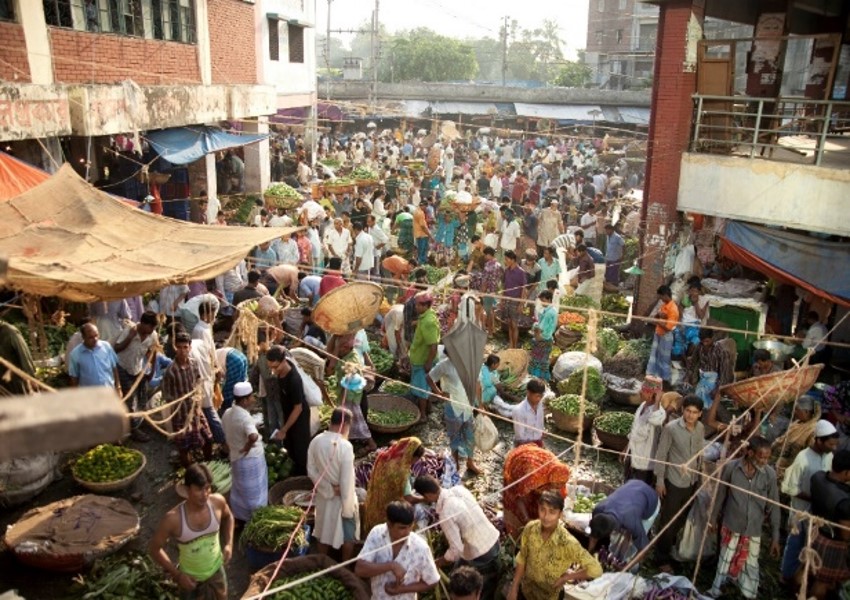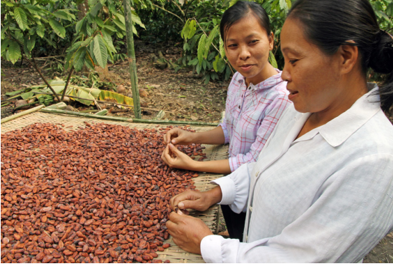In the latest of our guest blogs on the topic of the European Microfinance Award 2023 – Inclusive Finance for Food Security & Nutrition – Hans Ramm discusses the key global threats to food security and nutrition – and five ways – including with practical examples – that they can be addressed.
 The problem
The problem
The UN Food Systems Summit, held during the UN General Assembly in New York in September 2021, set the stage for global food systems transformation to achieve the Sustainable Development Goals by 2030. The meeting brought to the attention of national governments, development actors, food and non-food companies and investors, and civic sector actors the following three accelerating - and closely interconnected - global threats:
1. In 2021, 768 million people suffered from hunger - and 2.3 billion were food insecure.
2. Food production alone contributes to 25% of global CO2 emissions and the food demand value chains, including food processing and trading, make up 36%.
3. In 2020, 3.1 billion people could not afford a healthy diet. 40% of adults and 20% of children globally suffer from obesity and diet-related non-communicable diseases. And deaths attributable to poor diets have grown by 15% since 2010.
What does this mean? It means that food availability is not keeping up with population growth, although access to affordable food remains the still greater challenge due to accelerating poverty levels even in higher-income countries. Unhealthy diets – driven in part by the proliferation from the US fast food industry - will take long to reverse. The repercussions of the pandemic, political conflicts (like the Russian war in Ukraine) and more frequent and intense droughts and floods triggered by climate change further undermine the stability of the already unstainable food systems. Of course, the most vulnerable populations are threatened the most. The sustainable agriculture NGO Farming First identifies extreme gender disparities in access to key agricultural resources, particularly in Sub-Saharan Africa, relating to land (15%), inputs (<10%), extension services (5%), assets, markets, decision-making authority, and income.
 Five ways forward
Five ways forward
The Food Summit triggered five major action tracks (broken down by multiple workstreams and solutions) and pledging of enormous financial resources by public and private actors. However, many actions initiated by the UN and multilateral organisations in their ‘top-down’ and supply-driven operational modus vivendi will be unlikely to facilitate effective and systemic changes of food markets.
To avoid too much supply-driven activism, I believe there should be a focus on the following five market demand-driven and fiscal strategies to address the three main food security & nutrition threats outlined above, and I refer as examples to five promising blended finance case examples and a ‘true’ cost food study:
1. Internalisation of environmental and health costs of food production and consumption to be enforced by fiscal measures: Tax levies (as applied for cigarettes and alcohol) should be applied to environmentally damaging agri-chemicals so that the demand by food producers increases for comparatively ‘cheaper’ organic fertilisers and pesticides. This, in turn, encourages agricultural input suppliers to switch towards organic products.
The value-added taxes on food products need to compensate for the environmental and health costs of particular food items to encourage consumers to switch towards healthy food items, including subsidies for healthy food. This requires that the societal (or ‘true’) costs of food items are measured and then followed by fiscal measures targeted at the global food and beverage industries and their strong lobbies to reduce, for example, the high sugar content of their products. Stronger awareness building of governments in the aftermath of the Food Summit may finally overcome their decades-long food policy failure of higher taxes on sugar-prone food and beverages, despite a proven positive correlation between diabetes, cardiac diseases, dementia, etc and sugar intake.
A recent ‘true cost’ food study in Switzerland revealed that average food costs should be 90% higher than current market prices to internalise environmental (CO2 emissions, water pollution & use, biodiversity loss, etc) and health (diet-related non-communicable diseases) costs. Here are some examples of market versus ‘true’ costs for four selected food items per kg/l:
Market cost ‘True’ cost
Beef: 23.00 51.60
Chicken: 13.90 19.10
Milk: 1.50 0.80
Apples: 3.70 -2.90
 2. Agricultural investors incorporating key ESG risks of their investees into their investment pricing: This requires analysis (similar to ‘true’ costing) on how specific agricultural inputs affect the quality of produce, the resilience of crops against adverse weather events, soil fertility, etc. of their investees and local communities. This would cause a shift of investments towards more sustainable food production. Indeed, Rabobank, the global triple bottom-line agricultural investment leader, has developed ESG risk scorecards for different typologies of agricultural production since the mid-2000s for incorporation into its investment pricing.
2. Agricultural investors incorporating key ESG risks of their investees into their investment pricing: This requires analysis (similar to ‘true’ costing) on how specific agricultural inputs affect the quality of produce, the resilience of crops against adverse weather events, soil fertility, etc. of their investees and local communities. This would cause a shift of investments towards more sustainable food production. Indeed, Rabobank, the global triple bottom-line agricultural investment leader, has developed ESG risk scorecards for different typologies of agricultural production since the mid-2000s for incorporation into its investment pricing.
3. Strengthening the market positioning of smallholder farms within their agricultural value chains through ‘win-win’ partnerships with farmer organisations, value chain actors (input suppliers, processors, traders), and financial intermediaries, while supporting their transition to agro-ecological practices, are effective solutions to contribute to food security while reducing the negative environmental footprint. More than 500 million smallholder farms produce over 70% of global food and 90% of food in Sub-Saharan Africa. Inclusive growth of smallholder farming and agri-businesses also provides productive rural jobs and income - and is 2-3 times more effective in reducing poverty than growth in any other sector. There are promising blended-finance funder approaches with strong gender strategies to de-risk and deepen the ESG outcomes of investments by private smallholder agricultural impact investors. Examples include:
- Smallholder Safety Net Up-scaling Programme (SSNUP) is a multi-donor blended smallholder finance initiative, aims at sustainably strengthening resilience and the safety nets of ten million smallholder households over ten years. It is co-funding technical assistance for farmer organisations, agri-businesses, and financial intermediaries (being investees of the nine private agricultural impact investor partners) to: (i) develop/improve their financial and advisory services to smallholder clients; (ii) enhance market building linkages among agricultural value chain actors, including digitalisation of communication and business transactions; and (iii) upgrade their internal management and ESG performance.
- Aceli Africa is a multi-donor funded market-led platform offering first-loss financial incentives, social impact bonuses and technical assistance to local agricultural lenders and global impact investors. It thus reduces the “missing middle” by catalysing finance for credit-constrained agri-businesses along selected agricultural value chains that offer the best potential for income and job creation, food security and nutrition, gender and youth inclusiveness, and promotion of climate-smart and smallholder agriculture in Eastern Africa.
- Nutritious Foods Financing Facility is an innovative up-and-coming blended finance nutrition initiative, where GAIN facilitates more enabling environments for nutritious food and Incofin offers funding and technical assistance for businesses that support the supply of nutritious, safe food for domestic, low-income markets in Sub-Saharan Africa. It aims at four priorities: (1) increased access to nutritious food through wider distribution, improved affordability, variety, and desirability; (2) increased supply of nutrients and reduced harmful elements through improved reformulation; (3) increased food safety and reduced contamination during production; and (4) decreased food loss during production.
4. Facilitating digital transaction channels between smallholder farms and consumers to ensure direct market access and 'fair' prices. Whereas family farms are exploited by cartels of wholesalers and retail discounters in higher-income markets, they lose up to 40% of their harvest due to lacking storage/warehousing facilities and suffer from limited market access due to poor infrastructure in low-income countries. Two examples from Europe and Eastern Africa demonstrate this:
- Crowdfarming is a digital platform which provides logistics and customer service so that European farmers can sell their crops directly to the end-consumer. This cuts out the middlemen who control the market and pay the farmers prices that do often not even cover production costs. Crowdfarming fights against the 11% food waste at the source (crops not been harvested or not meeting optical standards of traditional market demands) thanks to crop adoption by the consumer. Pre-financing by consumers offers regular cash-flow to the farmers enabling them to invest in organic production while employing staff around the year at fair conditions.
- Apollo Agriculture is a digital platform which seeks to “redefine investment opportunities for farmers” in Eastern Africa by providing financing for better products, increasing their harvest, and turning their subsistence farming into commercial farming. Farmers can buy inputs in cash or credit by choosing from Apollo’s digital store and then picking it up at the closest of the more than one thousand agri-dealers. Credits are linked with drought/flood insurance coverage. Apollo offers agricultural training to all clients.
 5. Stimulating demand for affordable nutritious food as demand creates its supply. This encompasses multiple initiatives from school gardening and feeding programmes, food stamp programmes up to including health & nutrition in the primary and secondary school curricula. It is equally relevant in the South and North.
5. Stimulating demand for affordable nutritious food as demand creates its supply. This encompasses multiple initiatives from school gardening and feeding programmes, food stamp programmes up to including health & nutrition in the primary and secondary school curricula. It is equally relevant in the South and North.
The five strategies outlined above follow simple economic logic that market demand creates its supply (not the other way round) and that government has to ensure that all food production costs are internalised to protect the public (and ultimately the planet) against environmental destruction and mounting health costs. However, there are three broad challenges to the pursuit of these strategies:
Firstly, development actors still have little expertise and incentives in leveraging the knowledge and resources of the private sector through smart public-private partnerships to contribute to the Development Agenda 2030. Secondly, politicians show limited commitment beyond their next elections to address global food and nutrition threats and thus do not push sufficiently for regulatory/fiscal changes against strong lobbies from the global food and beverage industries. And thirdly, humans stick to old food habits even if they become fully aware of their negative health and environmental consequences and even if they have to pay more for them. Addressing these challenges will be critical in supporting the strategies to improve food security and nutrition.
Photo source: SDC


Leave a comment